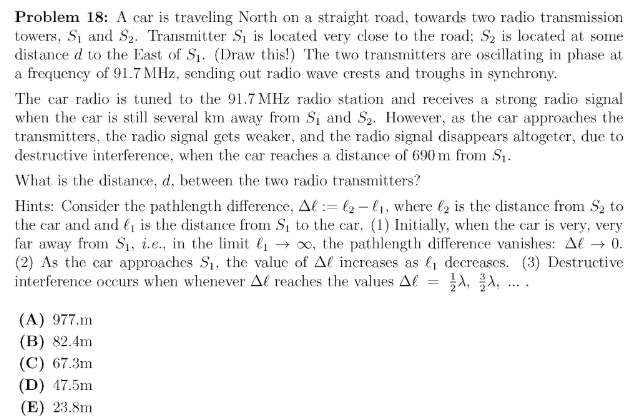Problem 18: A car is traveling North on a straight road, towards two radio transmission towers, S1 and S2. Transmitter S, is located very close to the road; S2 is located at some distance d to the East of S1. (Draw this!) The two transmitters are oscillating in phase at a frequency of 91.7 MHz, sending out radio wave crests and troughs in synchrony. The car radio is tuned to the 91.7 MHz radio station and receives a strong radio signal when the car is still several km away from S1 and S2. However, as the car approaches the transmitters, the radio signal gets weaker, and the radio signal disappears altogeter, due to destructive interference, when the car reaches a distance of 690 m from S1. What is the distance, d, between the two radio transmitters? Hints: Consider the pathlength difference, Al := l2 - 41, where l2 is the distance from Sz to the car and and li is the distance from S1 to the car. (1) Initially, when the car is very, very far away from Sı, i.e., in the limit l1 → x, the pathlength difference vanishes: Al → 0. (2) As the car approaches S1, the value of Al increases as l1 decreases. (3) Destructive interference occurs when whenever Al reaches the values Al A, A, . (A) 977.m (B) 82.4m (C) 67.3m (D) 47.5m (E) 23.8m
Problem 18: A car is traveling North on a straight road, towards two radio transmission towers, S1 and S2. Transmitter S, is located very close to the road; S2 is located at some distance d to the East of S1. (Draw this!) The two transmitters are oscillating in phase at a frequency of 91.7 MHz, sending out radio wave crests and troughs in synchrony. The car radio is tuned to the 91.7 MHz radio station and receives a strong radio signal when the car is still several km away from S1 and S2. However, as the car approaches the transmitters, the radio signal gets weaker, and the radio signal disappears altogeter, due to destructive interference, when the car reaches a distance of 690 m from S1. What is the distance, d, between the two radio transmitters? Hints: Consider the pathlength difference, Al := l2 - 41, where l2 is the distance from Sz to the car and and li is the distance from S1 to the car. (1) Initially, when the car is very, very far away from Sı, i.e., in the limit l1 → x, the pathlength difference vanishes: Al → 0. (2) As the car approaches S1, the value of Al increases as l1 decreases. (3) Destructive interference occurs when whenever Al reaches the values Al A, A, . (A) 977.m (B) 82.4m (C) 67.3m (D) 47.5m (E) 23.8m
Related questions
Question

Transcribed Image Text:Problem 18: A car is traveling North on a straight road, towards two radio transmission
towers, S1 and S2. Transmitter S, is located very close to the road; S2 is located at some
distance d to the East of S1. (Draw this!) The two transmitters are oscillating in phase at
a frequency of 91.7 MHz, sending out radio wave crests and troughs in synchrony.
The car radio is tuned to the 91.7 MHz radio station and receives a strong radio signal
when the car is still several km away from S1 and S2. However, as the car approaches the
transmitters, the radio signal gets weaker, and the radio signal disappears altogeter, due to
destructive interference, when the car reaches a distance of 690 m from S1.
What is the distance, d, between the two radio transmitters?
Hints: Consider the pathlength difference, Al := l2 - 41, where l2 is the distance from Sz to
the car and and li is the distance from S1 to the car. (1) Initially, when the car is very, very
far away from Sı, i.e., in the limit l1 → x, the pathlength difference vanishes: Al → 0.
(2) As the car approaches S1, the value of Al increases as l1 decreases. (3) Destructive
interference occurs when whenever Al reaches the values Al
A, A, .
(A) 977.m
(B) 82.4m
(C) 67.3m
(D) 47.5m
(E) 23.8m
Expert Solution
This question has been solved!
Explore an expertly crafted, step-by-step solution for a thorough understanding of key concepts.
This is a popular solution!
Trending now
This is a popular solution!
Step by step
Solved in 5 steps with 5 images
